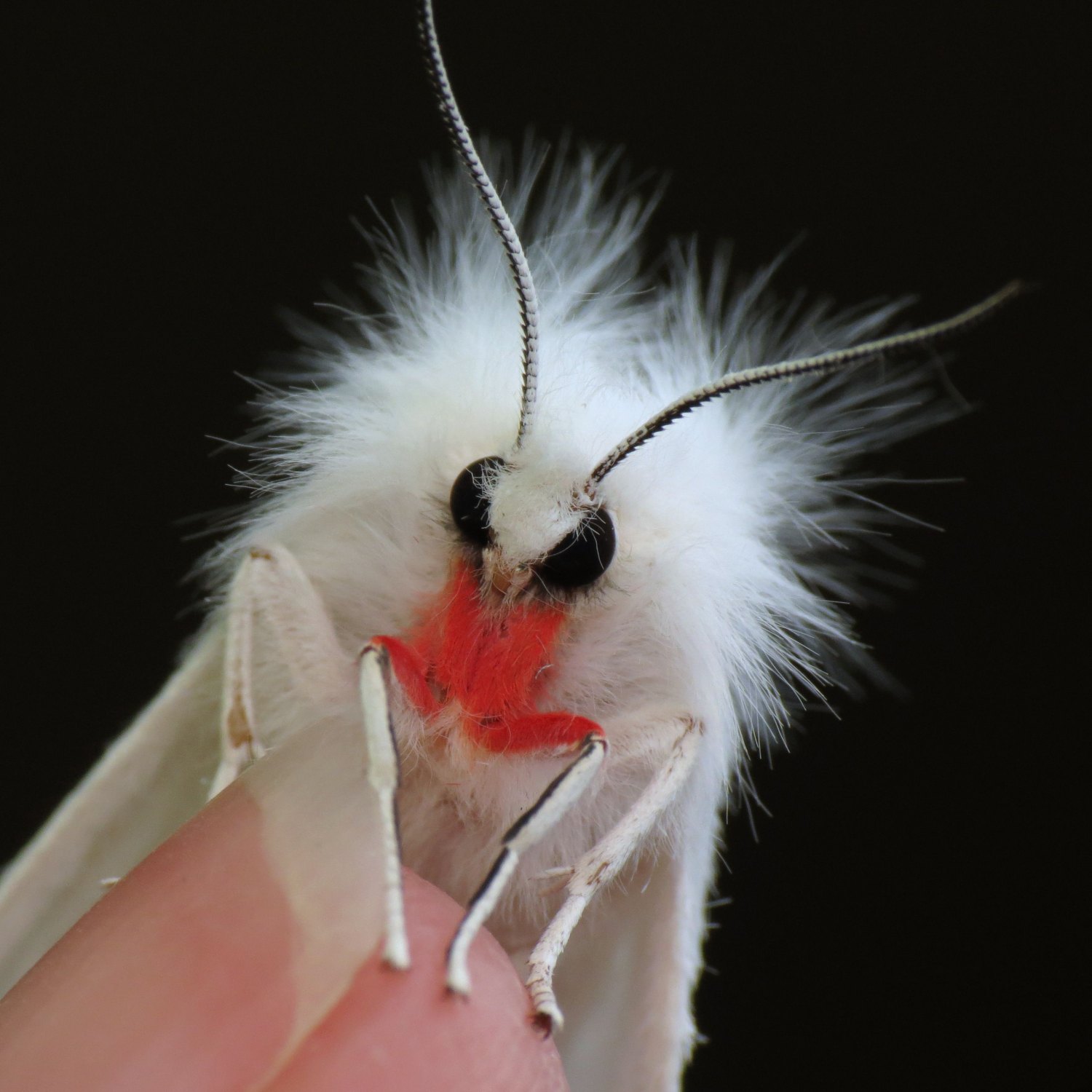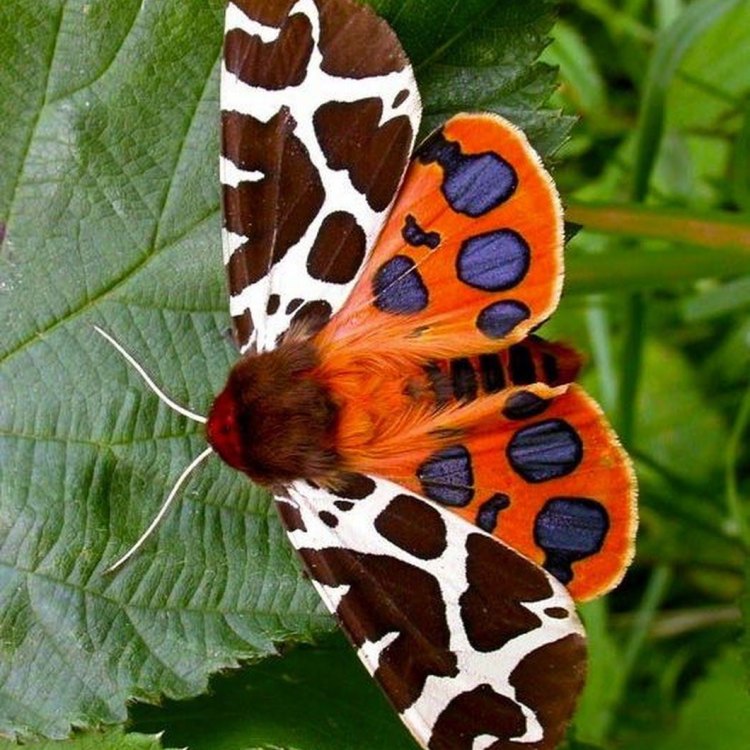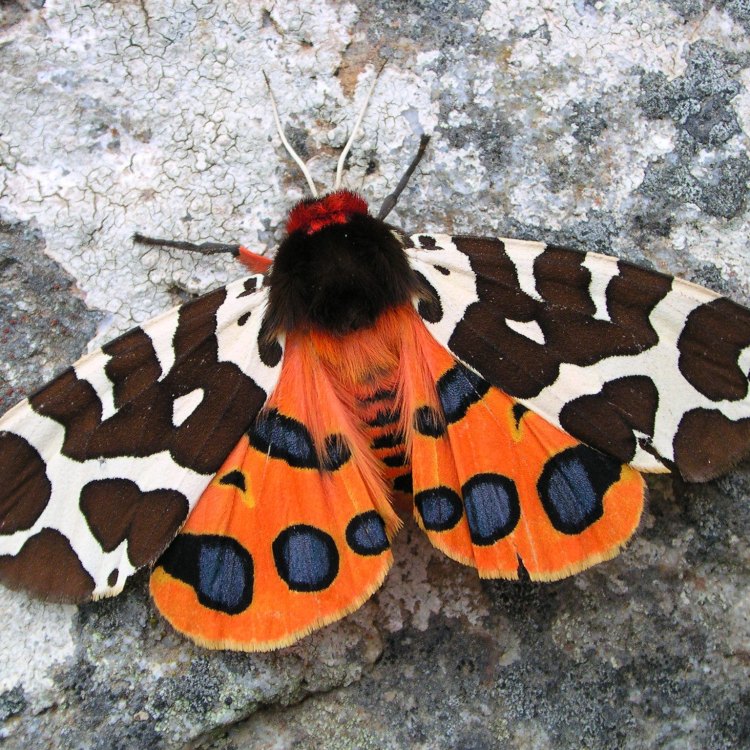
Tiger Moth
Approximately 1-2 inches
The Tiger Moth, a member of the Erebidae family, is a small to medium-sized moth with a stout body. Found in various locations, these beautiful insects typically measure only 1-2 inches in length. Their unique body shape makes them easily recognizable and a must-see for nature lovers. Keep your eyes open for these enchanting creatures during your next outdoor adventure! #tigermoth #erebidae #insects #naturelovers
Animal Details Summary:
Common Name: Tiger Moth
Kingdom: Animalia
Habitat: Various habitats including forests, grasslands, and gardens
The Majestic Tiger Moth: Nature's Vibrant Flying Wonder
There is a saying that beauty lies in simplicity, but when it comes to the tiger moth, beauty lies in its vibrant colors and patterns. This small to medium-sized insect belongs to the Arctiinae subfamily, commonly known as the tiger moth, and is a prime example of the wonders of nature. With its eye-catching colors and diverse habitats, the tiger moth is a species that deserves to be celebrated and admired. In this article, let’s delve deeper into the world of the tiger moth and discover why it’s a remarkable insect that commands our attention Tiger Moth.A Noble Ancestry
Before we explore the tiger moth’s features, let’s take a brief look at its scientific classification. The tiger moth belongs to the animal kingdom, a vast group encompassing all living organisms. Within the animal kingdom, it is classified under the phylum Arthropoda, a group that includes invertebrates such as insects, crustaceans, and arachnids. Further down the classification ladder, the tiger moth falls under the class Insecta and the order Lepidoptera, which also includes butterflies.The Tiger Moth’s Family: Erebidae
The tiger moth’s family, Erebidae, is a diverse group with over 25,000 species. The family name comes from the Greek word “erebus,” meaning darkness, which reflects the moths' nocturnal nature. Like its relatives, the tiger moth is primarily active at night and possesses excellent nocturnal vision.There are several types of tiger moths within the Erebidae family, each with unique characteristics. Some of the more well-known species include the garden tiger moth, giant leopard moth, and the Isabella tiger moth Troodon. Each species showcases distinctive colors and patterns, making them easy to identify.
The Thriving Habitats of the Tiger Moth
One of the remarkable features of the tiger moth is that it can thrive in a variety of habitats, making it a versatile and resilient species. These moths can be found all over the world, from the depths of tropical rainforests to temperate gardens. Their adaptability and ability to survive in diverse environments make them important pollinators and contributors to the ecosystem's balance.Some of the most common habitats for tiger moths include forests, grasslands, and gardens. They are also prevalent in urban areas, making them familiar to those living in cities. However, their exact geographical distribution is not limited to certain countries or regions since they can be found almost anywhere, except for polar regions.
Surviving as a Herbivore
Like many other insect species, the tiger moth is a herbivore, which means that it primarily feeds on plants and plant-based materials. It is essential in the ecosystem as a natural herbivore, keeping the balance of plant populations in check. However, unlike most herbivorous insects, the tiger moth has a preference for specific types of plants.The caterpillar stage of the tiger moth is particularly picky, as they feed only on specific plant species such as milkweed or stinging nettle. These plants contain toxins that caterpillars can ingest without being harmed, making them crucial for their survival and development. The toxicity of these plants also makes the tiger moth larvae less appealing to predators, a clever survival tactic.
The Beauty of the Tiger Moth's Colors
One of the most striking traits of the tiger moth is its bright, colorful wings. These wings are adorned with intricate patterns and designs that have captured the attention of scientists and nature enthusiasts alike. The reason for these vibrant colors is still a bit of a mystery, but scientists believe it serves as a form of defense.When a predator comes near, the tiger moth can spread its wings, exposing the bright colors and patterns. This unexpected display can startle the predator and even make it think twice about its intended prey. Some species of tiger moth have evolved to have markings that resemble the eyes of a much larger animal, further confusing potential predators.
A Stout Body with a Unique Shape
Apart from their colorful wings, tiger moths also have a distinct body shape. Unlike butterflies, which have slender bodies, the tiger moth has a stout, chunky body. It is also fuzzier and appears to have a softer texture. This body composition is essential for maintaining body heat, especially during colder climates when the moths huddle together to keep warm.Another unique feature of the tiger moth’s body is its ability to produce ultrasonic sounds. Researchers have discovered that some species produce these high-frequency sounds to outcompete bats, which use echolocation to find their prey. This ability not only helps the moths evade their predators but also serves as a form of communication among themselves.
Tiger Moths: Small but Mighty
Despite their small size, tiger moths pack quite a punch when it comes to their contribution to the ecosystem. As pollinators, they play a vital role in the reproduction of plants, contributing to the growth of forests and maintaining the diversity of plant populations. They are also a crucial food source for many other animals, including birds and small mammals.In addition, the tiger moth's adaptability and resilience have allowed them to become a prominent species, even in urban environments. Their presence in gardens and parks means that they are continuously interacting and helping to shape our surroundings, whether we realize it or not.
The Fascinating World of Tiger Moths
From its diverse habitats to its eye-catching colors and patterns, the tiger moth has proven to be a remarkable and intriguing insect. Its resilience, adaptability, and essential role in the ecosystem make it a valuable species that we should strive to protect and understand further.Despite its small size, the tiger moth has managed to capture our attention and teach us that beauty comes in all shapes, sizes, and colors. The next time you see this tiny insect fluttering about, take a moment to appreciate its unique qualities and remember that appearances can be deceiving. The tiger moth is proof that sometimes, the most magnificent things come in the smallest packages.

Tiger Moth
Animal Details Tiger Moth - Scientific Name: Arctiinae
- Category: Animals T
- Scientific Name: Arctiinae
- Common Name: Tiger Moth
- Kingdom: Animalia
- Phylum: Arthropoda
- Class: Insecta
- Order: Lepidoptera
- Family: Erebidae
- Habitat: Various habitats including forests, grasslands, and gardens
- Feeding Method: Herbivorous
- Geographical Distribution: Found worldwide, except in the polar regions
- Country of Origin: Not applicable
- Location: Various locations
- Animal Coloration: Brightly colored and patterned wings
- Body Shape: Small to medium-sized with a stout body
- Length: Approximately 1-2 inches

Tiger Moth
- Adult Size: Small to medium-sized
- Average Lifespan: Varies by species
- Reproduction: Sexual reproduction
- Reproductive Behavior: Mating occurs during the night
- Sound or Call: No specific sound or call
- Migration Pattern: Some species migrate
- Social Groups: Solitary
- Behavior: Nocturnal
- Threats: Habitat loss and pesticide use
- Conservation Status: Varies by species
- Impact on Ecosystem: Important pollinators and prey for predators
- Human Use: Some species are used in biological control and research
- Distinctive Features: Brightly colored wings and hairy body
- Interesting Facts: Tiger moths are known for their ability to produce ultrasonic clicks to deter bats
- Predator: Birds, bats, spiders, and other insectivorous animals

Arctiinae
The Fascinating World of the Tiger Moth
In the insect world, there are over a million known species, each with its own unique characteristics and behaviors. Among them is the fascinating Tiger Moth, a small to medium-sized insect that belongs to the family Arctiidae. These moths can be found in various regions of the world, including Asia, Africa, and the Americas, and are known for their distinctively bright and colorful wings.But there is so much more to these creatures than just their appearance PeaceOfAnimals.Com. In this article, we will delve into the world of the Tiger Moth and discover the interesting facts, behaviors, and impact they have on the ecosystem and humans alike.
Physical Characteristics and Behavior
Tiger Moths have a wingspan that ranges from 1 to 2 inches, depending on the species. They are generally small to medium-sized insects, with some being as tiny as a fingernail. Their bodies are covered in tiny hairs, giving them a soft and fuzzy appearance. These hairs also serve as a defense mechanism against predators, as they can irritate the mouth and digestive tract of any animal that attempts to eat them.
One of the most distinctive features of the Tiger Moth is its brightly colored wings. These wings come in a variety of patterns and colors, including orange, yellow, and black. The purpose of these striking colors is to deter predators, as they often signal that the moths are not a tasty meal. Some species of Tiger Moths also have eye-like markings on their wings, which can confuse predators and potentially save them from being eaten Tibetan Mastiff.
Tiger Moths are primarily nocturnal creatures, meaning they are most active at night. During the day, they will rest and camouflage themselves on plants, rocks, or other surfaces. They are solitary creatures and do not form social groups or colonies, with the exception of a few species that may migrate in groups. These moths are also known for being agile flyers, using their strong wings to navigate through the dark of the night.
Mating and Reproduction
Tiger Moths reproduce through sexual reproduction, with males and females coming together to mate. The mating process typically occurs during the night, with the male finding a suitable mate through pheromones released by the female. Once they have mated, the female Tiger Moth will lay eggs on a suitable host plant, where they will hatch into caterpillars.
The lifespan of a Tiger Moth varies by species, with some living only a few weeks as adults, while others can live up to a year. As caterpillars, they go through several stages of growth, shedding their skin as they grow larger and eventually forming a cocoon where they will remain until they emerge as adult moths.
Threats and Conservation Status
Like many other species in the animal kingdom, Tiger Moths face several threats, including habitat loss and pesticide use. These moths rely on specific host plants for feeding and reproducing, and when these plants are destroyed or altered, it can have a significant impact on their survival.
Pesticides, specifically those used in agriculture, can also have detrimental effects on Tiger Moths. These chemicals can harm the larvae, causing deformities, or even lead to their death. In some areas, the use of pesticides has led to the decline of certain species of Tiger Moths.
The conservation status of Tiger Moths varies by species. Some are considered threatened or endangered, while others are in stable populations. Conserving their habitats and reducing the use of harmful pesticides are crucial to ensuring the survival of these fascinating creatures.
Impact on Ecosystem and Human Use
Tiger Moths play a vital role in the ecosystem as both pollinators and prey for other animals. As they feed on nectar from flowers and other plants, they help to pollinate them, aiding in the reproduction of these plants. They are also a food source for many predators, including birds, bats, spiders, and other insectivorous animals.
Humans have also found uses for Tiger Moths in the fields of biological control and research. Some species of Tiger Moths are used as biological control agents, meaning they are introduced to control insect pests that can harm crops. They are also commonly used in scientific research to study their unique defensive abilities, including their ultrasonic clicks, which we will explore in the next section.
Interesting Facts about Tiger Moths
Tiger Moths have some intriguing abilities that set them apart from other insects. One of the most remarkable facts about these creatures is their ability to produce ultrasonic clicks. These clicks, which are similar to the sounds bats use to navigate, act as a defense mechanism when threatened by a bat. By producing these clicks, the Tiger Moth can jam the bat's echolocation system, making it difficult for them to locate and catch the moth.
Another interesting fact about Tiger Moths is that they can produce a chemical that tastes bitter to predators. This chemical is stored in the caterpillar's body, and when threatened, it can release it, preventing the predator from completing its meal. Some species of Tiger Moths also have the ability to secrete a sticky substance when disturbed, helping them to escape predators.
In Conclusion
The world of the Tiger Moth is full of unique characteristics and behaviors that make them a truly fascinating insect. From their brightly colored wings to their ability to produce ultrasonic clicks, these creatures have captured the interest of scientists and nature enthusiasts alike.
However, like many other species, Tiger Moths face threats that endanger their survival. It is essential to protect their habitats and reduce the use of harmful pesticides to ensure their continued existence in the wild. By understanding more about these fascinating creatures, we can appreciate their role in the ecosystem and work towards their conservation. Next time you see a Tiger Moth fluttering by, take a moment to admire their beauty and uniqueness.

The Majestic Tiger Moth: Nature's Vibrant Flying Wonder
Disclaimer: The content provided is for informational purposes only. We cannot guarantee the accuracy of the information on this page 100%. All information provided here may change without prior notice.












